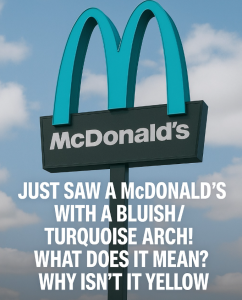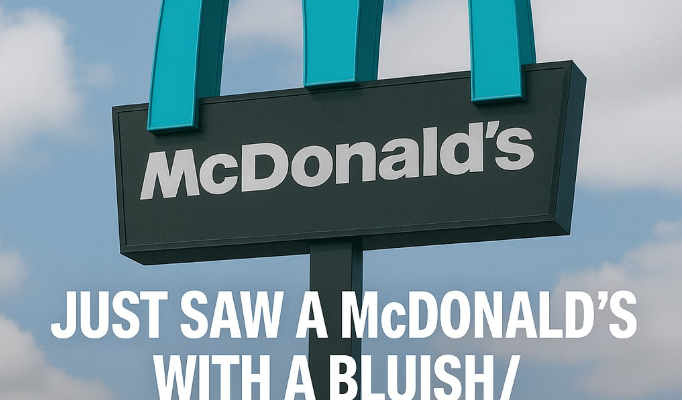Why One McDonald’s Has Turquoise Arches
When you picture McDonald’s, one image likely leaps into your mind before anything else: the famous golden arches. Those towering yellow “M’s” have become one of the most recognizable symbols in the world, rivaling even the cross and the Olympic rings in instant recognizability. They shine on highways, in downtown streets, and in tiny towns across America. But in one unusual location, the arches aren’t gold at all—they’re turquoise.
Yes, a McDonald’s exists with blue-green arches instead of the familiar golden glow. The story of this restaurant is not only quirky trivia—it’s a fascinating case study in branding, local culture, and the way even global giants must sometimes adapt.
The Location: Sedona, Arizona
The only McDonald’s with turquoise arches is located in Sedona, Arizona, a desert city famous for its dramatic red rock formations, tourism, and artsy, spiritual vibe. Millions of visitors each year flock to Sedona for its hiking trails, vortex energy sites, and striking landscapes that appear painted by hand. The city is also fiercely protective of its beauty.
When McDonald’s came knocking in the early 1990s, city officials had one clear priority: protecting Sedona’s natural aesthetic. They weren’t about to let a garish fast-food franchise disrupt their carefully cultivated desert harmony.
Why Not Gold?
Gold, after all, is McDonald’s signature color. The golden arches are synonymous with fast food, childhood memories, convenience, and sometimes guilty pleasure. But in Sedona, gold wasn’t just bold—it was too bold.
City planners argued that bright yellow clashed violently with Sedona’s natural palette of rusty reds, soft tans, and muted greens. Allowing glaring yellow arches would set a precedent for other businesses to disregard Sedona’s strict building codes, threatening the very atmosphere that made the city special.
So, they made a deal with McDonald’s: no golden arches. If the company wanted to open a franchise in Sedona, they would have to adapt.
The Birth of the Turquoise Arches
Rather than walking away, McDonald’s complied. Designers worked with the city to find a compromise that satisfied both the corporation’s need for visibility and the community’s need for aesthetic preservation.
The result? Arches painted turquoise, a color that blended harmoniously with the sky and surrounding red rocks. Instead of screaming for attention, the arches appear almost soothing, a part of the landscape rather than an interruption of it.
When the Sedona McDonald’s opened in 1993, it instantly became a landmark—not just for locals, but for curious tourists who wanted to see the arches that broke the rules.
Public Reaction
At first, some wondered whether the unusual arches would confuse customers or weaken the brand’s consistency. After all, isn’t the golden arch as essential to McDonald’s as the Big Mac? But the opposite happened: the turquoise arches became a draw.
Tourists line up to take photos with the unusual sign. It’s become one of the most photographed McDonald’s in the world, rivaling even the ultra-modern glass-and-steel McDonald’s in Times Square. Travel bloggers, TikTokers, and Instagram influencers now flock to Sedona, sometimes just to snap a picture with the offbeat logo.
For Sedona residents, the turquoise arches became a symbol of their city’s stubborn uniqueness. It proved that even the world’s biggest corporations could be forced to bend when local culture took a stand.
Branding Meets Local Culture
The Sedona McDonald’s story highlights an important truth: global brands may seem untouchable, but they aren’t immune to local influence. McDonald’s is a master at maintaining consistency—same menu staples, same golden arches—but it has also shown flexibility when necessary.
For example:
-
In India, McDonald’s serves McAloo Tikki burgers to cater to vegetarians.
-
In Japan, you’ll find shrimp burgers.
-
In France, the menu includes macarons and espresso.
Sedona’s turquoise arches fall into that same category of cultural adaptation. Instead of changing the menu, McDonald’s altered its visual identity—a bold but successful move.
Why Turquoise?
Of all colors, why turquoise? Local officials wanted something that reflected the sky, the turquoise jewelry tied to Native American culture in the region, and the Southwest aesthetic. Turquoise is a color deeply associated with Arizona’s indigenous history and artistry.
For McDonald’s, turquoise offered a way to keep the arches distinct but still recognizable. The “M” shape itself is iconic enough that, even in another color, customers instantly recognize it.
The Legacy of the Turquoise Arches
Over 30 years later, the Sedona McDonald’s remains the only one in the world with turquoise arches. Even other Arizona McDonald’s franchises—some built near scenic areas—were never required to alter their colors. Sedona’s fierce dedication to its visual environment makes it a one-of-a-kind case.
The restaurant has become something of a pilgrimage site for McDonald’s enthusiasts, brand historians, and casual travelers alike. Tour buses often include a stop there, and social media continues to spread its fame.
Lessons in Branding and Identity
The turquoise arches show that brand power doesn’t always come from strict uniformity. Sometimes, bending the rules creates a stronger connection with customers. In fact, the Sedona McDonald’s might be more famous precisely because it broke tradition.
This case offers lessons for businesses of all sizes:
-
Respect Local Culture – Global consistency matters, but not at the cost of alienating a community.
-
Flexibility Can Strengthen Identity – Instead of weakening the McDonald’s brand, the turquoise arches made it even more memorable.
-
Uniqueness Attracts Tourists – People love novelties. The unusual arches gave Sedona an additional tourist attraction, boosting both McDonald’s and the city.
Beyond McDonald’s: Other Adaptations Around the World
Sedona’s turquoise arches are not the only time McDonald’s has adapted its image. In Paris, one McDonald’s sign glows white instead of yellow, blending into the city’s chic aesthetic. In Bruges, Belgium, the arches were made smaller to avoid overwhelming the historic architecture.
These examples prove that even the mightiest global icons must occasionally take a back seat to cultural or environmental priorities.
Final Reflection
The McDonald’s in Sedona, Arizona, is more than just a place to grab fries or a burger. It’s a reminder that identity is not only about boldness—it’s also about adaptability. The turquoise arches are proof that sometimes, to truly stand out, you have to blend in.
What began as a restriction became a triumph of branding and local pride. Tourists don’t just come to eat at that McDonald’s; they come to experience a story. A story of compromise, creativity, and the surprising beauty of seeing something familiar in a completely new light.
So the next time you see golden arches on the highway, remember: in one small city in Arizona, they’re turquoise. And that, ironically, might make them more golden than ever.


